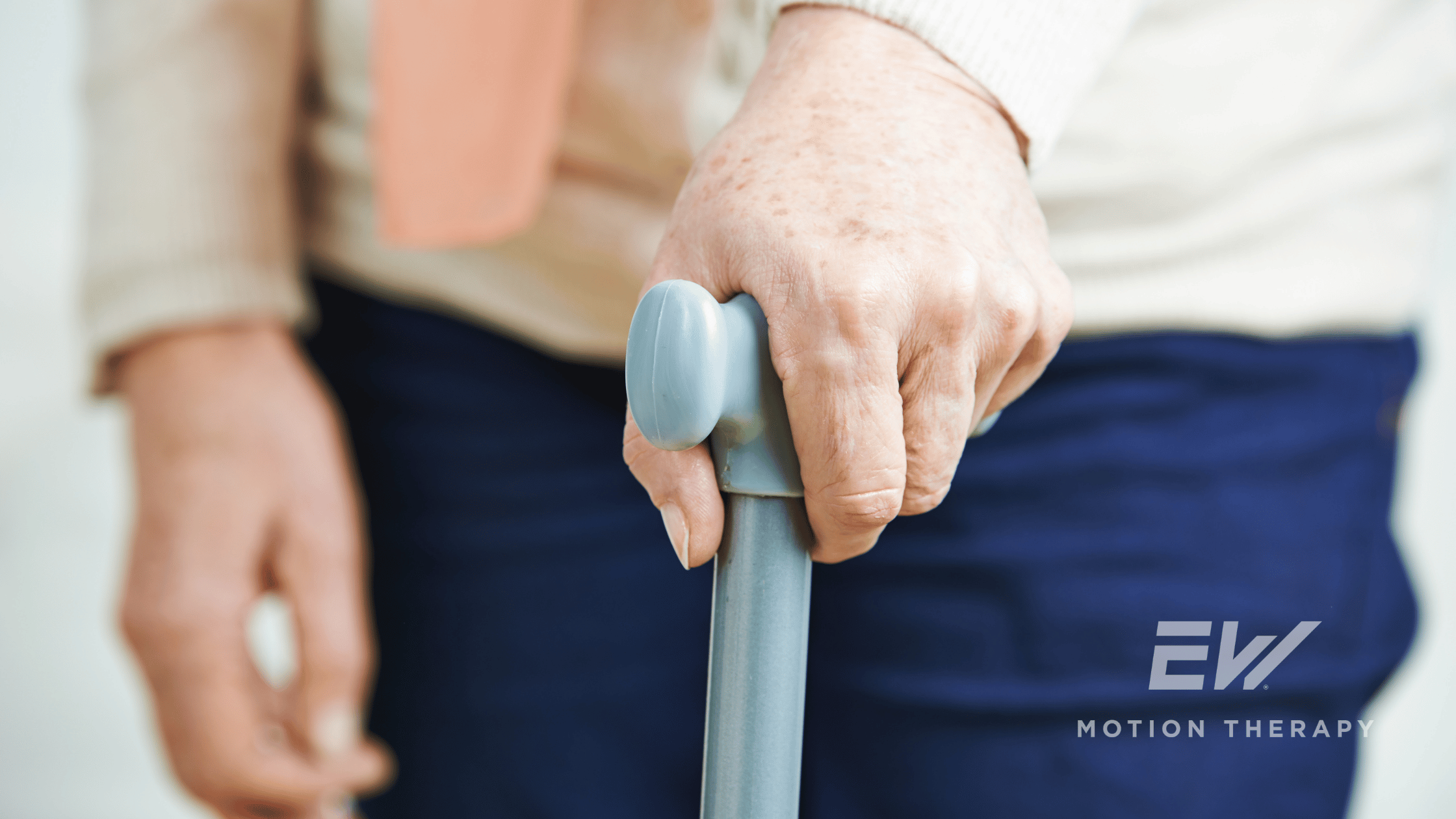Osteoporosis vs Osteopenia: What You Need To Know

Motion Specialist // EW Motion Therapy Homewood
Osteoporosis and osteopenia are common bone conditions affecting millions worldwide, particularly as they age. Both conditions involve a reduction in bone density, making bones more fragile and susceptible to fractures. However, they differ in severity, progression, and management strategies. Physical therapy is a cornerstone of managing osteopenia and osteoporosis, offering tailored exercises, balance training, and pain management techniques that empower individuals to maintain bone health and reduce fracture risk. We love helping patients with decreased bone density at EW Motion Therapy stay healthy and active while building strength and reducing fall risk. Even if you decide that our services don’t fit your needs, understanding the nuances between osteoporosis and osteopenia is crucial for prevention, early intervention, and effective treatment.
What are osteoporosis and osteopenia?
Osteopenia is a condition characterized by lower-than-normal bone density that is not severe enough to be classified as osteoporosis. It is often considered a precursor to osteoporosis and serves as a warning sign that bone density is decreasing. People with osteopenia are at an increased risk of developing osteoporosis if no preventive measures are taken.
Osteoporosis is a more severe condition in which bone density has decreased significantly, leading to brittle bones that are prone to fractures, even with minor stresses such as coughing or bending over. Because bone loss occurs without symptoms until a fracture occurs, osteoporosis is often termed the “silent disease.”
How do these conditions progress?
Both osteoporosis and osteopenia involve bone thinning and weakening due to decreased bone mineral density. Let’s examine how they typically progress.
Throughout life, bones undergo a continuous process of remodeling, where old bone tissue is broken down (resorption) and new bone tissue is formed (formation). In young and healthy individuals, this process is balanced. However, as people age, the rate of bone resorption begins to outpace bone formation, leading to a gradual decrease in bone density.
The progression begins with a reduction in bone mass, often detected through a bone mineral density (BMD) test. A BMD test measures the density of minerals (such as calcium) in your bones, and the results are compared to a standard reference. If the BMD score falls between -1.0 and -2.5 on the T-score scale, it indicates osteopenia.
If bone density continues to decrease beyond the osteopenia range, the condition progresses to osteoporosis. A T-score of -2.5 or lower indicates osteoporosis, and the risk of fractures increases substantially. Osteoporosis often goes unnoticed until a fracture occurs, which can lead to significant pain, disability, and a decline in quality of life.
Can osteopenia and osteoporosis be prevented?
Prevention plays a crucial role in managing both osteopenia and osteoporosis, and several strategies can help:
Diet and nutrition
Adequate intake of calcium and vitamin D is essential for bone health. Calcium helps build and maintain strong bones, while vitamin D improves calcium absorption. Foods rich in these nutrients, such as dairy products, leafy greens, and fortified foods, should be a staple in your diet. Supplements may also be recommended if dietary intake is insufficient.
Regular exercise
Weight-bearing and resistance exercises are beneficial in maintaining bone density. Activities like walking, jogging, dancing, and lifting weights stimulate bone formation and slow down bone loss. Regular exercise also improves muscle strength, balance, and coordination, which can help prevent falls and fractures. Movement practices like Pilates can also be beneficial, focusing on core strength and body awareness.
Lifestyle modifications
Along with your diet, avoiding smoking and limiting alcohol consumption are important preventive measures. Smoking and excessive alcohol intake can accelerate bone loss and increase fracture risk.
Bone density testing
Bone density testing, often done through a dual-energy X-ray absorptiometry (DEXA) scan, is a crucial tool for detecting osteopenia and osteoporosis. This test measures the density of minerals, like calcium, in your bones and provides a T-score that helps assess your bone health. Regular bone density testing is especially important for individuals over the age of 50, but certain risk factors may necessitate earlier testing. Early detection of low bone density allows for timely intervention, which can prevent progression to more severe bone loss and reduce the risk of fractures.
Several risk factors can increase the likelihood of developing osteopenia or osteoporosis, suggesting that bone density testing should be considered sooner. Here are some of the most significant risk factors:
- Age: As people age, the risk of bone density loss increases due to hormonal changes and a natural decline in bone formation. Women over the age of 65 and men over the age of 70 are generally recommended to undergo routine bone density testing. However, younger individuals with risk factors should also consider earlier testing.
- Gender: Women are at a higher risk of developing osteopenia and osteoporosis, particularly post-menopause, due to the sharp decline in estrogen levels, which plays a protective role in bone health. Men also experience bone loss as they age, but at a slower rate.
- Family history: A family history of osteoporosis or fractures, particularly hip fractures, can increase your risk. Genetics plays a significant role in bone health, and having a parent or sibling with osteoporosis may warrant earlier testing.
- Hormonal factors: Conditions that affect hormone levels, such as early menopause (before age 45), hysterectomy (especially with removal of the ovaries), and prolonged absence of menstrual periods (amenorrhea) due to excessive exercise or eating disorders, can accelerate bone loss.
- Certain medical conditions: Various medical conditions can affect bone density, including rheumatoid arthritis, chronic kidney disease, thyroid disorders (such as hyperthyroidism), gastrointestinal diseases (like celiac disease or Crohn’s disease), and diabetes. Individuals with these conditions may need more frequent or earlier bone density evaluations.
- Medications: Long-term use of certain medications can contribute to bone loss. These include corticosteroids (such as prednisone), anti-seizure medications, chemotherapy drugs, and certain treatments for breast cancer (aromatase inhibitors) and prostate cancer (androgen deprivation therapy).
- Lifestyle factors: Smoking, excessive alcohol consumption, a sedentary lifestyle, and a diet low in calcium and vitamin D can increase the risk of reduced bone density. Individuals with these lifestyle factors should consider testing to assess their bone health.
- Low body weight: Individuals with a body mass index (BMI) below 19 or those who have experienced significant weight loss are at increased risk for bone loss. Low body weight can lead to decreased bone mass and may warrant earlier bone density testing.
- History of fractures: Experiencing a fracture after the age of 50 can be a strong indicator of osteoporosis. Individuals with a history of fractures from low-impact events should undergo bone density testing to assess their risk for future fractures.
If you or a loved one has one or more of these risk factors, discussing bone density testing with a healthcare provider is important, even if they are under the typical age threshold. Early testing can provide valuable insights into bone health, enabling proactive measures to prevent further bone loss.
Treatment options for osteopenia and osteoporosis
While prevention is key, treatment options vary depending on the severity of bone loss and the presence of symptoms.
Medications
For osteopenia, doctors may recommend lifestyle changes and supplements initially. Medications like bisphosphonates, selective estrogen receptor modulators (SERMs), or hormone replacement therapy may be considered if there is a high risk of fracture.
For osteoporosis, more aggressive treatment is often necessary. In addition to bisphosphonates, other medications like denosumab, teriparatide, or abaloparatide may be prescribed to help slow bone loss or increase bone formation.
Supplements
Calcium and vitamin D supplements are commonly recommended for both conditions. An adequate intake of these nutrients supports overall bone health and can help prevent further bone loss.
Lifestyle adjustments
Maintaining a healthy diet, engaging in regular physical activity, and making safety modifications at home (like installing grab bars and improving lighting) can reduce the risk of falls and fractures.
Physical therapy
Physical therapy plays a significant role in managing osteopenia and osteoporosis. A physical therapist can design a personalized exercise program to improve bone strength, enhance balance, and prevent falls. They can also educate patients on safe movement techniques and posture to protect fragile bones.
How physical therapy can help
Physical therapy is an invaluable component of a comprehensive treatment plan for osteopenia and osteoporosis. Here’s how it can help:
- Strength training: Physical therapists guide patients through safe and effective strength training exercises that target key muscle groups. Strengthening muscles around the spine and hips, which are common sites of fractures, helps protect bones and maintain function.
- Balance and fall prevention: Balance exercises are crucial for individuals with osteoporosis or osteopenia, as they help reduce the risk of falls—a major cause of fractures. Physical therapists use balance training, gait analysis, and coordination exercises to enhance stability and confidence in daily movements.
- Postural education: Proper posture minimizes stress on the spine and reduces the risk of vertebral fractures. Physical therapists teach posture correction techniques and ergonomic adjustments to help patients move safely throughout their daily activities.
- Pain management: Physical therapy can aid in pain management and recovery for individuals who have already experienced fractures. Therapists employ modalities such as manual therapy, therapeutic exercises, and gentle stretches to alleviate pain and improve mobility.
- Education and lifestyle advice: Physical therapists provide valuable education on maintaining bone health through lifestyle changes. They work closely with patients to develop strategies to incorporate exercise into their routines and make safe choices to protect their bones.
Osteopenia and osteoporosis are conditions that can significantly impact bone health and quality of life if left unmanaged. While osteopenia represents a milder reduction in bone density, it serves as a critical warning sign for potential progression to osteoporosis. Early detection, preventive strategies, and effective treatment plans are vital for treating both conditions and helping you maintain an active lifestyle. Physical therapy is often an essential part of treating both osteopenia and osteoporosis. To learn more about what it might cost, click the button below to download our free pricing guide.



